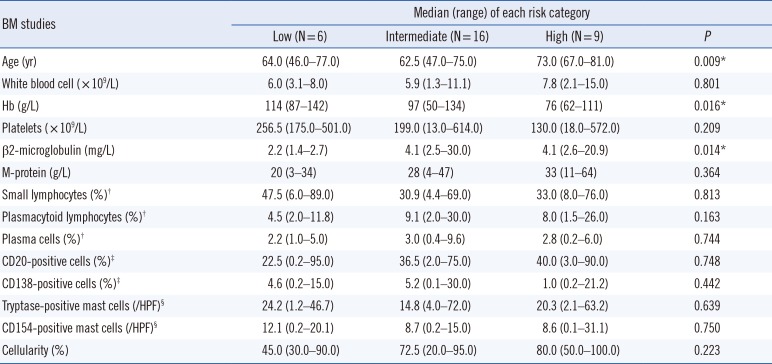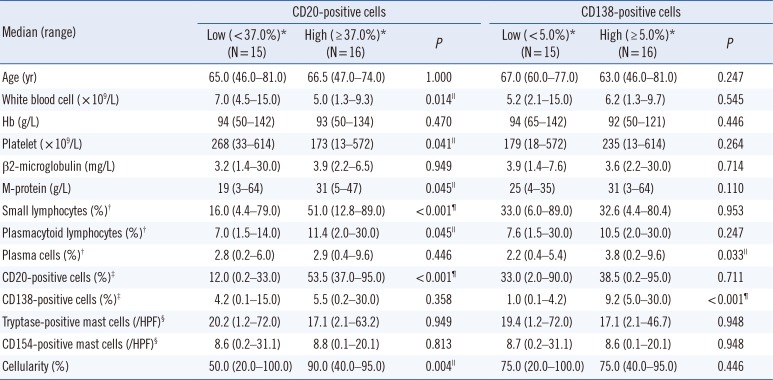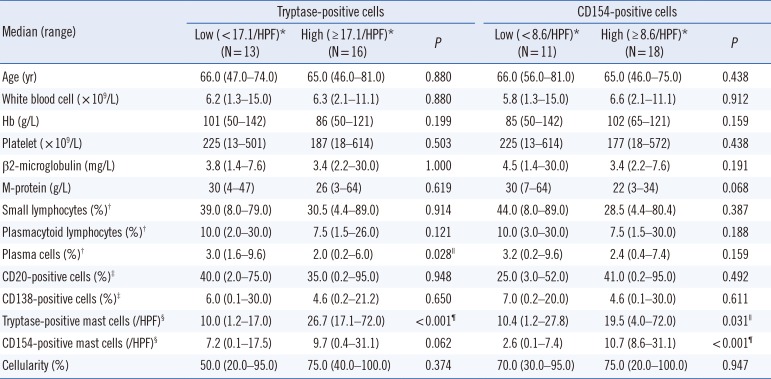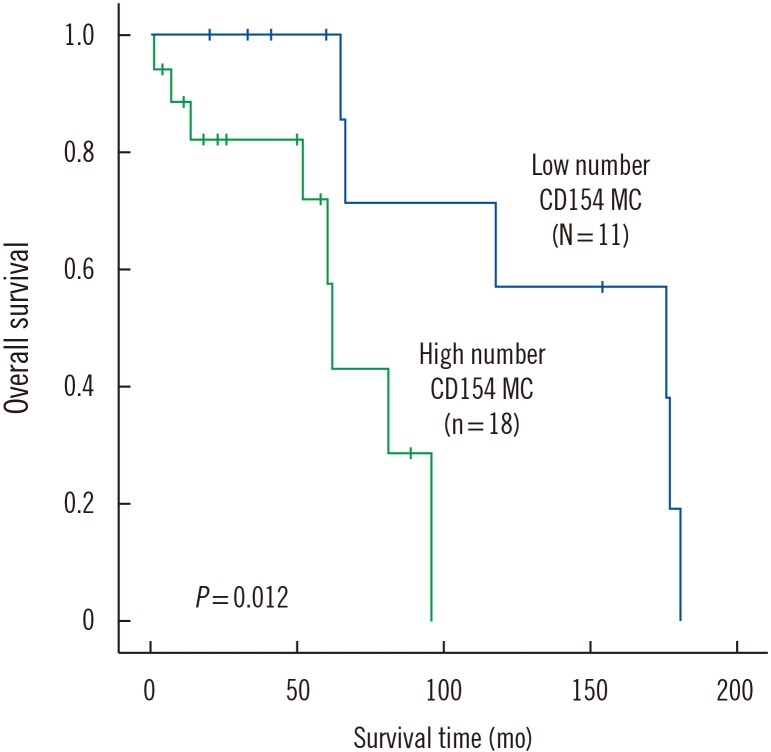1. Naderi N, Yang DT. Lymphoplasmacytic lymphoma and Waldenström macroglobulinemia. Arch Pathol Lab Med. 2013; 137:580–585. PMID:
23544948.
2. Swerdlow SH, Campo E, editors. WHO classification of tumours of haematopoietic and lymphoid tissues. 4ed. Lyon: IARC;2017. p. 232–235.
3. Arcaini L, Varettoni M, Boveri E, Orlandi E, Rattotti S, Zibellini S, et al. Distinctive clinical and histological features of Waldenström's macroglobulinemia and splenic marginal zone lymphoma. Clin Lymphoma Myeloma Leuk. 2011; 11:103–105. PMID:
21454204.
4. Klodzinska S, Vos JM, Kersten MJ, Wijermans P, Minnema MC. A survey on diagnostic methods and treatment strategies used in patients with Waldenström's macroglobulinaemia in the Netherlands. Neth J Med. 2013; 71:90–96. PMID:
23462060.
5. Tabata R, Yasumizu R, Tabata C, Kojima M. Bone marrow macrophages in Waldenström's macroglobulinemia: a report of four cases. J Clin Exp Hematop. 2014; 54:103–110. PMID:
25318942.
6. Santos DD, Hatjiharissi E, Tournilhac O, Chemaly MZ, Leleu X, Xu L, et al. CD52 is expressed on human mast cells and is a potential therapeutic target in Waldenström's macroglobulinemia and mast cell disorders. Clin Lymphoma Myeloma. 2006; 6:478–483. PMID:
16796779.
7. Tournilhac O, Santos DD, Xu L, Kutok J, Tai YT, Le Gouill S, et al. Mast cells in Waldenstrom's macroglobulinemia support lymphoplasmacytic cell growth through CD154/CD40 signaling. Ann Oncol. 2006; 17:1275–1282. PMID:
16788002.
8. Treon SP. XIII. Waldenström's macroglobulinaemia: an indolent B-cell lymphoma with distinct molecular and clinical features. Hematol Oncol. 2013; 31 Suppl 1:76–80. PMID:
23775655.
9. D'Souza A, Ansell S, Reeder C, Gertz MA. Waldenström macroglobulinaemia: the key questions. Br J Haematol. 2013; 162:295–303. PMID:
23651417.
10. Gertz MA. Waldenström macroglobulinemia: 2017 update on diagnosis, risk stratification, and management. Am J Hematol. 2017; 92:209–217. PMID:
28094456.
11. McGowan-Jordan J. ISCN 2016: An International System for Human Cytogenomic Nomenclature (2016): recommendations of the International Standing Committee on Human Cytogenomic Nomenclature including new sequence-based cytogenetic nomenclature developed in collaboration with the Human Genome Variation Society (HGVS) sequence variant description working group. Karger;2016.
12. O'Donnell LR, Alder SL, Balis UJ, Perkins SL, Kjeldsberg CR. Immunohistochemical reference ranges for B lymphocytes in bone marrow biopsy paraffin sections. Am J Clin Pathol. 1995; 104:517–523. PMID:
7572811.
13. Park M, Park CJ, Cho YW, Jang S, Lee JH, Lee JH, et al. Alterations in the bone marrow microenvironment may elicit defective hematopoiesis: a comparison of aplastic anemia, chronic myeloid leukemia, and normal bone marrow. Exp Hematol. 2017; 45:56–63. PMID:
27693387.
14. Morra E, Varettoni M, Tedeschi A, Arcaini L, Ricci F, Pascutto C, et al. Associated cancers in Waldenström macroglobulinemia: clues for common genetic predisposition. Clin Lymphoma Myeloma Leuk. 2013; 13:700–703. PMID:
24070824.
15. Kyrtsonis MC, Levidou G, Korkolopoulou P, Koulieris E, Bartzi V, Maltezas D, et al. CD138 expression helps distinguishing Waldenström's macroglobulinemia (WM) from splenic marginal zone lymphoma (SMZL). Clin Lymphoma Myeloma Leuk. 2011; 11:99–102. PMID:
21454203.
16. Seegmiller AC, Xu Y, McKenna RW, Karandikar NJ. Immunophenotypic differentiation between neoplastic plasma cells in mature B-cell lymphoma vs plasma cell myeloma. Am J Clin Pathol. 2007; 127:176–181. PMID:
17210522.
17. Yamasaki S, Matsushita H, Tanimura S, Nakatani T, Hara S, Endo Y, et al. B-cell lymphoma of mucosa-associated lymphoid tissue of the thymus: a report of two cases with a background of Sjögren's syndrome and monoclonal gammopathy. Hum Pathol. 1998; 29:1021–1024. PMID:
9744322.
18. Tursi A, Modeo ME. Monoclonal gammopathy of undetermined significance predisposing to Helicobacter pylori-related gastric mucosa-associated lymphoid tissue lymphoma. J Clin Gastroenterol. 2002; 34:147–149. PMID:
11782609.
19. Tirelli A, Guastafierro S, Cava B, Lucivero G. Triclonal gammopathy in an extranodal non-Hodgkin lymphoma patient. Am J Hematol. 2003; 73:273–275. PMID:
12879432.
20. Kim HJ, Hur M, Kim H, Moon HW, Yun YM, Kim SY, et al. A rare case of Waldenström macroglobulinemia/lymphoplasmacytic lymphoma with light chain discrepancy between B lymphocyte population and serum paraprotein. Ann Clin Lab Sci. 2015; 45:593–597. PMID:
26586715.
21. Owen RG, Barrans SL, Richards SJ, O'Connor SJ, Child JA, Parapia LA, et al. Waldenström macroglobulinemia. Development of diagnostic criteria and identification of prognostic factors. Am J Clin Pathol. 2001; 116:420–428. PMID:
11554171.
22. Liu EB, Zhang PH, Li ZQ, Sun Q, Yang QY, Fang LH, et al. Clinicopathologic features of lymphoplasmacytic lymphoma. Zhonghua Bing Li Xue Za Zhi. 2010; 39:308–312. PMID:
20654153.
23. Lapidot T, Kollet O. The essential roles of the chemokine SDF-1 and its receptor CXCR4 in human stem cell homing and repopulation of transplanted immune-deficient NOD/SCID and NOD/SCID/B2m(null) mice. Leukemia. 2002; 16:1992–2003. PMID:
12357350.
24. Agarwal A, Ghobrial IM. The bone marrow microenvironment in Waldenström macroglobulinemia. Clin Lymphoma Myeloma Leuk. 2013; 13:218–221. PMID:
23490994.
25. Yoo D, Lessin LS, Jensen WN. Bone-marrow mast cells in lymphoproliferative disorders. Ann Intern Med. 1978; 88:753–757. PMID:
666133.
26. Yoo D, Lessin LS. Bone marrow mast cell content in preleukemic syndrome. Am J Med. 1982; 73:539–542. PMID:
6957149.
27. Nixon RK. The relation of mastocytosis and lymphomatous disease. Ann Intern Med. 1966; 64:856–860. PMID:
23841206.
28. Prokocimer M, Polliack A. Increased bone marrow mast cells in preleukemic syndromes, acute leukemia, and lymphoproliferative disorders. Am J Clin Pathol. 1981; 75:34–38. PMID:
7457427.
29. Molin D, Edström A, Glimelius I, Glimelius B, Nilsson G, Sundström C, et al. Mast cell infiltration correlates with poor prognosis in Hodgkin's lymphoma. Br J Haematol. 2002; 119:122–124. PMID:
12358914.
30. Theoharides TC, Conti P. Mast cells: the Jekyll and Hyde of tumor growth. Trends Immunol. 2004; 25:235–241. PMID:
15099563.
31. Hiromatsu Y, Toda S. Mast cells and angiogenesis. Microsc Res Tech. 2003; 60:64–69. PMID:
12500262.
32. Gauchat JF, Henchoz S, Mazzei G, Aubry JP, Brunner T, Blasey H, et al. Induction of human IgE synthesis in B cells by mast cells and basophils. Nature. 1993; 365:340–343. PMID:
7690905.
33. Pawankar R, Okuda M, Yssel H, Okumura K, Ra C. Nasal mast cells in perennial allergic rhinitics exhibit increased expression of the Fc epsilonRI, CD40L, IL-4, and IL-13, and can induce IgE synthesis in B cells. J Clin Invest. 1997; 99:1492–1499. PMID:
9119992.









 PDF
PDF ePub
ePub Citation
Citation Print
Print




 XML Download
XML Download